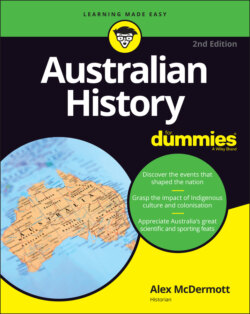Читать книгу Australian History For Dummies - Alex McDermott - Страница 68
Courting disaster with the interlopers
ОглавлениеThe local Eora and Darug people had pragmatically tried to adjust to the invasion, as fear and curiosity mingled on either side of the massive cultural divide. To begin with at least, relations were more cordial than hostile. Many of the marine officers were fascinated with these people from a completely ‘new’ and previously unknown culture. The Indigenous Australians mostly got along with the officers — the young warrior men especially.
With convicts, however, relations between black and white quickly soured. Quite early on — in May 1788 — two young convicts, William Okey and Samuel Davis, were killed while cutting grass at a place now known as Rushcutters Bay to make a thatch roof for the Store House. The killings were gruesome — the bodies described as ‘jellied’ — and while their clothes and provisions were untouched, their rush-cutting tools were taken. The exact cause of the death of these two was difficult to establish, but the settlement’s surgeon, John White, suspected that ‘from the civility shown on all occasions to the officers by the natives, whenever any of them were met, I am strongly inclined to think that they must have been provoked and injured by the convicts’. Phillip thought likewise.
Indigenous–convict relations continued to degenerate. Aboriginal Australians, prizing warrior prowess and with a keen eye for status and prestige, largely enjoyed the company of First Fleet officers, who were for their part more curious and respectful than hostile. Convicts and Aboriginals, however, despised each other. Mutual distrust reigned, and thefts, rape and payback killings began to increase.
But the convicts themselves weren’t the great fracturing event. A year after the killings at Rushcutters Bay, a smallpox epidemic struck the settlement. Most of the white settlers had already established immunity to the disease, but the effect on Indigenous Australians was devastating. Some 50 per cent of Aboriginal people in the Sydney region died as a consequence.
This, as much as the Rushcutters Bay deaths, was to be the tragic signature tune for the encounter between British and Indigenous societies as settlement spread outward. However many Aboriginal people died as a result of direct conflict with the white invaders and targeted killings — and plenty did — the impact of epidemic diseases, to which they had no established immunity, was far more devastating. Combined with the effect of a brand new intoxicant — alcohol — the consequences of white settlement were profound.
